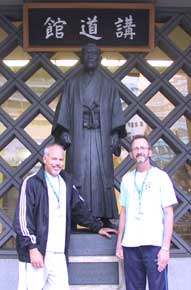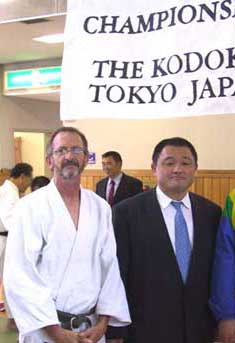by Bill Gaffney, yondan
There were lots of reasons not to come. How could I compete with the Japanese or anyone else who had the guts to show up? It was expensive. Care for my young children presented a logistical problem. On the other hand this was the Kodokan, a trip to Tokyo, a chance to do something that was a fantasy. Nicholas Rostelli from New York said it best when he said “I‘ve been doing judo all my life. I couldn’t see giving up a chance to fight here.” Every judoka I spoke to felt much the same way. The Irish, English, Brazilians, Germans, everyone agreed the thought of coming to the Kodokan was too much to resist I began to think about the people in my life who never had the chance to do something like this. These are friends who were visited by tragedy early in life, my judo buddies who would have jumped at the chance to go to Japan — my friend Don Jones, a dedicated judoka who died in his thirties of Leukemia, or my friend Jim Neithercott who became paraplegic after a tragic car accident. Both men loved judo and were always up for an adventurous road trip. My twin brother Jim who is recovering from multiple strokes and is severely compromised physically is a personal reminder of fate’s fickleness. In addition to those considerations, there were recent tragedies at the national level and in my personal sphere that led to a philosophy of eating your dessert first, you never know what life has around the next corner. These considerations tipped me toward the trip. When I brought the idea up with the head instructor of our dojo, Neil Ohlenkamp, he volunteered to go as my coach and as a representative for the website JudoInfo.com. I was in good health, the expense would be a stretch, but with the support of my wife and children I trained a little harder and saved for the trip.
Recently, I viewed the video made by Fighting Films, “Koga a New Wind,” and the interviews took place in the Kodokan’s 8th floor gallery with the 7th floor competition area as the backdrop. Hey, I was there too! Wow! The first person I ran into was the Brazilian team coach Nelson Niseda, two time gold medalist at 66kg. I met Nelson at the 2001 world championships in Scottsdale, Arizona. He was my opponent in the 66kg, M5 division. His warmth and good will were apparent from the beginning. We shared few words but we were able to communicate our mutual admiration and respect. The Brazilian judo was as impressive as they were enthusiastic. When a Brazilian was on the mat there was lots of cheering and energy from the crowd. I spoke with Katia Da Silva who won the F2 52 kg division about her matches. Katia had three ippons on her way to the gold medal. I had the opportunity to watch two of her matches and she fought like a tiger. She won with tai otoshi and ippon seionage. Her daily training was apparent. When I asked her favorite throw she said,” I have no favorite, I use the best technique for the situation”. Getting more time to train is a problem. Balancing family, teaching responsibilities and judo is an ongoing challenge. I wasn’t able to train every day, but I was able to average 4 times a week thanks to a Brazilian ju jitsu class that meets in the early mornings led by Rickson Gracie student Craig Husband. The group consists of are dedicated grapplers who helped me improve my matwork immeasurably. Craig is a terrific coach and eclectic martial artist. I feel very fortunate to have the opportunity to train with him. Competing in the M8 division was Andor Paposi Job former Hungarian National Champion and freedom fighter now living in the US. In addition to his judo activities, he trained by building two stone walls. Multi talented, Andor’s latest hobby is oil painting. He has recently begun his third oil portrait of distinguished judoists. He fought so well I am considering building a wall around my back yard The Irish were well represented. The Irish are noted for their warmth and hospitality and they did not disappoint. I found myself surrounded by Irish medalists as we watched the open competition. Starting with Willie Lyons, “the first Irishman to win a medal at the Kodokan,” we had a grand time sitting around trading the blarney and even talking about judo. In our company were two time gold medalists Kiren Foley M4 73kg and Jack Dennis M6 90kg division. The judo gene runs in Jack’s family as his sons John and Tom are on the Irish team and his daughter Ellie is Irish champion.
Most everyone I talked to were here as part of a journey. Taichi Hayashi with his wife Diane from El Paso Texas had a dual purpose. He was drawn to Japan to bring his father’s ashes here and to compete at the Kodokan to honor his memory. I watched one of Taichi’s matches, his dad would have enjoyed it as he won with shime waza. The idea of coming to the Kodokan and competing is for the average guy the pinnacle of a judo career. This opinion was shared by Bill Sargent from the English contingent. The Japanese were fabulous. They won about half the medals awarded and represented the birthplace of judo spectacularly. I overheard two Australians commenting on Japanese judo. They said, “The Japanese are very technical. They set you up and go for the big throw.” They were that.
The Kodokan, with it’s wealth of tradition, made training and competing on the 7th floor a highlight of my judo life that will be hard to surpass. Witnessing the camaraderie and friendship that occurred in a time when the world is short of both gives me hope. Mutual benefit and welfare can also be translated “you and me shining together”. I felt for the last week of June 2003 a small diverse group from around the world were “shining together”. Master’s judo is alive and well. I think Jigoro Kano would have been proud Author’s Note: This account of the 2003 World Masters Championship in Tokyo |
 “He who can suppress a moment’s anger may prevent |


 Surreal is the word I kept using as Neil and I took in Tokyo. After the long plane trip and late arrival to our hotel we visited the Kodokan first thing. Surreal. Finally here it was. We put on our gi’s and joined the thousands who walked the floors before us. We were standing on the shoulders of giants, to paraphrase Sir Issac Newton. Judo greats, like Kudo,
Surreal is the word I kept using as Neil and I took in Tokyo. After the long plane trip and late arrival to our hotel we visited the Kodokan first thing. Surreal. Finally here it was. We put on our gi’s and joined the thousands who walked the floors before us. We were standing on the shoulders of giants, to paraphrase Sir Issac Newton. Judo greats, like Kudo, 
